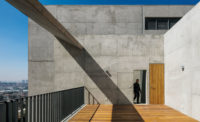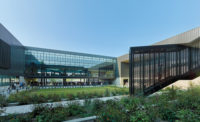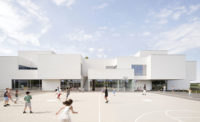When Brazilian bank Bradesco vacated a charmless 1970s office block in the Greater São Paulo city of Osasco, few imagined the building would go on to enjoy a second life as an innovative new high school. Nonetheless, this was exactly the future envisioned by Fundação Bradesco, the charitable foundation set up by the bank.
Expanding the building would help the foundation alleviate overcrowding at its nearby Osasco school, one of 40 such facilities that it runs across Brazil to provide free education to over 100,000 largely disadvantaged children ill-served by Brazil’s woefully inadequate system. And for Shieh Arquitetos, charged with overseeing the transformation, the project was an opportunity to inject new thinking into an educational network that still produces uninspired schools with inward-looking classrooms feeding off joyless, narrow corridors. Though the project was a private commission, Shieh Shueh Yau, founder of the local firm, aims to spur change in public school design, opening up possibilities for more social environments, combined with daylit, flexible spaces—ideas long adopted in the U.S. and other countries. “I hope the project will demonstrate how architecture can play a part in improving education here,” he says.
Additional Content:
Jump to credits & specifications
To that end, the design team has turned the onetime office building into a luminous, transparent center for education—a feat achieved largely by replacing concrete walls with expanses of glass and wrapping the building in an elegant, aluminum brise-soleil to mitigate glare and heat gain. The architects started by stripping the original concrete structure back to its steel skeleton and then stripping some more. By removing parts of the floor slabs, the team carved out a soaring atrium at the front entrance, complementing an existing, though now expanded, one at the rear. Housing open stairs topped by skylights, the atria carry daylight deep into the building to the loungelike commons, which are the heart of the new school. These teakwood-lined spaces, where students kick back on beanbags or work at fixed wood benches, not only encourage social interaction and informal study, but also connect vertical circulation to the classrooms and other areas. Moreover, these spaces eliminate the need for corridors, which Shieh and his son and partner Leonardo describe as aesthetically and socially detrimental.
One of the design team’s biggest challenges was how to efficiently handle the circulation for over 1,300 teenagers (who attend either a morning or afternoon session) in a four-story, 33,000-square-foot facility. “We kept the classrooms on the second and third levels to avoid too much vertical circulation by such a large number of students,” explains Leonardo. “Then, on the top floor, we have the less intensively used spaces, such as the laboratories, auditorium, and library.”
Students can enter the second level up a gentle ramp from the street. But the principal reception area is on the below-grade ground floor, accessed by stairs. Here, a multiuse indoor-outdoor area includes the school refectory and a retaining wall, cleverly disguised as seating for a small outdoor amphitheater, where students can hang out between classes. While the spare, white-walled classrooms are sober, the rest of the school, with its unprogrammed spaces and whimsical furnishings, feels something like a funky university arts building. Nowhere is this sensation more potent than on the top level: the architects eliminated the brise-soleil from the street-facing facade to create brighter, open spaces for the labs, library, and auditorium, which are separated by glass walls, and which seem to dissolve into the cityscape beyond. It is on this level that principal Nahid Nakib Gil most notices the impact that the new environment has had on students. “The library is always full, and students use the school much more for studying outside of class time,” she says. “They were enchanted with the building when they saw it, and now they value it more.”
Two of her charges could not agree more. “The library is sensational,” says Bianca, 17. “I feel more comfortable studying here than at home—the new building gives you the desire to study.” Her friend Barbara, 18, puts it another way: “Before, school was all closed spaces and small windows. Other schools we studied in felt like prison in comparison. Here, there is so much glass, you have a sense of freedom.”
CreditsArchitect: Shieh Arquitetos Associados, Alameda Jau 1533 cj3 Sao Paulo SP Brazil 01420-002, +55 11 3083 1430, www.shieh.com.br
Personnel in architect's firm who should receive special credit: Shieh Shueh Yau, Leonardo Shieh, Irene Shieh, Lenita Pimentel, Karen Minoda, Nathalia Grippa, Ricardo Azevedo, Yuhu Minami, Juliana Stendard
Interior designer: Shieh Arquitetos Associados
Engineers Mechanical: Thermoplan Electrical: PHE Plumbing: PHE Structure: Prodenge Foundation: MG&A
Consultants Acoustical: Alexandre Sresnewsky Façade: Dinaflex Environmental: Jörg Spangenberg Landscape design: Rosa Grena Kliass, Luisa Mellis Lighting design: Franco Associados Visual design: João Nitsche
General contractor: InovaTS
Photographer: Fernando Stankuns |
SpecificationsStructural System Metalon Zanaga
Exterior Cladding EIFS, ACM, or other: Kiir Curtain wall: Kiir Other cladding unique to this project: Expanded Aluminum Panels: Permetal
Roofing Metal: Metalon
Windows Metal frame: Kiir
Glazing Glass: Kiir Skylights: Kiir
Doors Entrances: Carvalho Wood doors: Carvalho
Hardware Locksets: Yale La Fonte
Interior Finishes Acoustical ceilings: Knauf Glass partitions: Abatex Cabinetwork and custom woodwork: Carvalho Paints and stains: Coral Floor and wall tile: Braston, Jatobá, NBK Vinyl flooring: Forbo
Furnishings Office furniture: Riccó Fixed seating: InsideOffice Chairs: Riccó Tables: Fernando Jaeger Other furniture: Metadil
Lighting Interior ambient lighting: Bertolucci Tasklighting: Lumini Exterior: Lumini
Conveyance Elevators/escalators: Otis
Plumbing Faucet: Deca Lavatory: Deca Drinking Fountain: IBBL Stormwater Drainage: Ulma |















Post a comment to this article
Report Abusive Comment